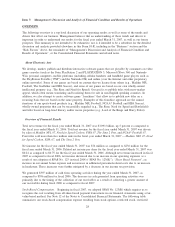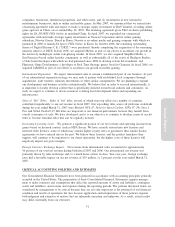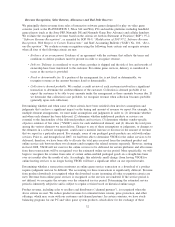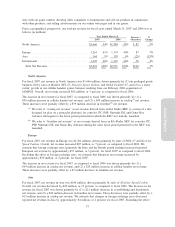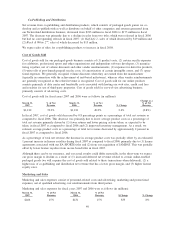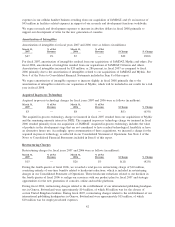Electronic Arts 2007 Annual Report Download - page 107
Download and view the complete annual report
Please find page 107 of the 2007 Electronic Arts annual report below. You can navigate through the pages in the report by either clicking on the pages listed below, or by using the keyword search tool below to find specific information within the annual report.
products by resellers under certain circumstances. It is our general practice to exchange products or give
credits rather than to give cash refunds.
In certain countries, from time to time, we decide to provide price protection for both our PC and video game
system products. When evaluating the adequacy of sales returns and price protection allowances, we analyze
historical returns, current sell-through of distributor and retailer inventory of our products, current trends in
retail and the video game segment, changes in customer demand and acceptance of our products, and other
related factors. In addition, we monitor the volume of sales to our channel partners and their inventories, as
substantial overstocking in the distribution channel could result in high returns or higher price protection costs
in subsequent periods.
In the future, actual returns and price protections may materially exceed our estimates as unsold products in
the distribution channels are exposed to rapid changes in consumer preferences, market conditions or
technological obsolescence due to new platforms, product updates or competing products. For example, the
risk of product returns and/or price protection for our products may continue to increase as the PlayStation 2
console moves through its lifecycle. While we believe we can make reliable estimates regarding these matters,
these estimates are inherently subjective. Accordingly, if our estimates changed, our returns and price
protection reserves would change, which would impact the total net revenue we report. For example, if actual
returns and/or price protection were significantly greater than the reserves we have established, our actual
results would decrease our reported total net revenue. Conversely, if actual returns and/or price protection were
significantly less than our reserves, this would increase our reported total net revenue.
Significant judgment is required to estimate our allowance for doubtful accounts in any accounting period. We
determine our allowance for doubtful accounts by evaluating customer creditworthiness in the context of
current economic trends and historical experience. Depending upon the overall economic climate and the
financial condition of our customers, the amount and timing of our bad debt expense and cash collection could
change significantly.
Royalties and Licenses
Our royalty expenses consist of payments to (1) content licensors, (2) independent software developers, and
(3) co-publishing and distribution affiliates. License royalties consist of payments made to celebrities,
professional sports organizations, movie studios and other organizations for our use of their trademarks,
copyrights, personal publicity rights, content and/or other intellectual property. Royalty payments to indepen-
dent software developers are payments for the development of intellectual property related to our games. Co-
publishing and distribution royalties are payments made to third parties for the delivery of product.
Royalty-based obligations with content licensors and distribution affiliates are either paid in advance and
capitalized as prepaid royalties or are accrued as incurred and subsequently paid. These royalty-based
obligations are generally expensed to cost of goods sold generally at the greater of the contractual rate or an
effective royalty rate based on expected net product sales. Significant judgment is required to estimate the
effective royalty rate for a particular contract. Because the computation of effective royalty rates requires us to
project future revenue, it is inherently subjective as our future revenue projections must anticipate a number of
factors, including (1) the total number of titles subject to the contract, (2) the timing of the release of these
titles, (3) the number of software units we expect to sell which can be impacted by a number of variables,
including product quality and competition, and (4) future pricing. Determining the effective royalty rate for
our titles is particularly challenging due to the inherent difficulty in predicting the popularity of entertainment
products. Accordingly, if our future revenue projections change, our effective royalty rates would change,
which could impact the royalty expense we recognize. Prepayments made to thinly capitalized independent
software developers and co-publishing affiliates are generally made in connection with the development of a
particular product and, therefore, we are generally subject to development risk prior to the release of the
product. Accordingly, payments that are due prior to completion of a product are generally amortized to
research and development over the development period as the services are incurred. Payments due after
completion of the product (primarily royalty-based in nature) are generally expensed as cost of goods sold.
Annual Report
33







